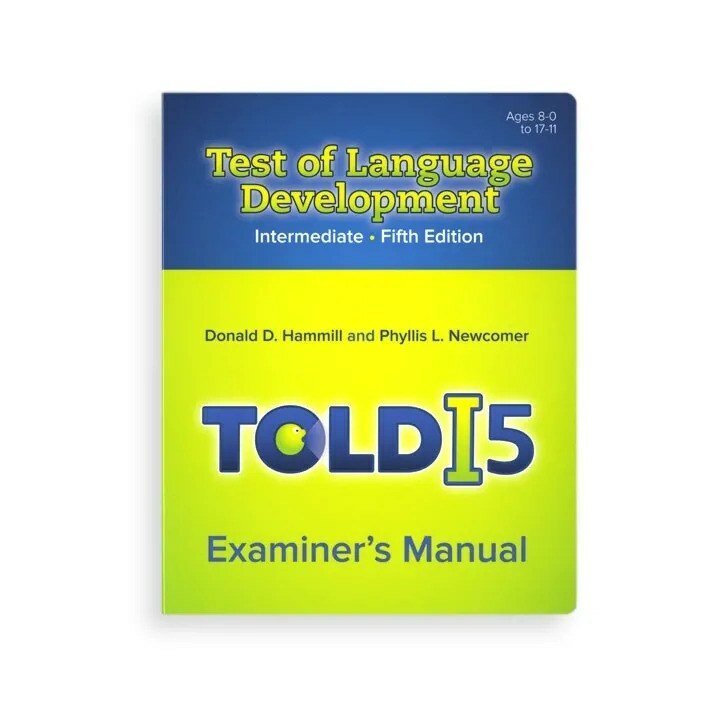Please specify the quantity of product(s).



Test of Language Development–Intermediate: Fifth Edition (TOLD-I:5)
| Item | Product | Price | QTY |
|---|---|---|---|
| 31486 | TOLD-I:5 Kit | $345.00 | |
| 31486R | TOLD-I:5 Record Forms, Pk/25 | $98.00 | |
| 31486M | TOLD-I:5 Manual | $113.00 | |
| 31486P | TOLD-I:5 Picture Book | $134.00 |
Donald D. Hammill and Phyllis L. Newcomer
| BENEFITS | Assesses spoken language in intermediate-age students |
| AGES | 8 years, 0 months to 17 years, 11 months |
| ADMIN TIME | 30 to 60 minutes |
| SCORES | Age equivalents, percentile ranks, subtest scaled scores, and composite indexes |
| NORMS | Stratified by age to conform to the characteristics of the projected U.S. school-age population for the year 2015 |
The TOLD-I:5 has six subtests that measure various aspects of oral language. The results of these subtests can be combined to form composite scores for the major dimensions of language: semantics and grammar; listening, organizing, and speaking; and overall language ability.
Professionals can use the TOLD-I:5 to:
- Identify students who are significantly below their peers in oral language proficiency
- Determine their specific strengths and weaknesses in oral language skills
- Document their progress in remedial programs
- Measure oral language in research studies
Subtests
- Sentence Combining—measures the ability to combine two to five short, simple sentences into one complex or compound sentence while retaining all the meaning expressed in the short sentences (grammar, speaking)
- Picture Vocabulary—measures the ability to understand the meanings of spoken two-word phrases (semantics, listening)
- Word Ordering—measures the ability to construct a meaningful sentence from a set of words presented orally in a random sequence (grammar, organizing)
- Relational Vocabulary—measures the ability to identify the abstract relationship existing among a set of spoken words (semantics, organizing)
- Morphological Comprehension—measures the ability to recognize ungrammatical spoken sentences (grammar, listening)
- Multiple Meanings—measures the ability to provide different meanings for spoken stimulus words (semantics, speaking)
Normative Scores
The TOLD-I:5 yields four types of normative scores: age equivalents, percentile ranks, subtest scaled scores, and composite indexes. Percentiles provide the examiner with an index that is easily understood by parents and others with whom the test results are to be shared. Subtest scaled scores are based on a distribution having a mean of 10 and standard deviation of 3. Composite indexes are based on a distribution having a mean of 100 and standard deviation of 15. Age equivalents are indexes of relative standing that translate subtest raw scores to what are commonly termed “language ages.”
New Features of the TOLD-I:5
- All-new normative data were stratified by age to conform to the characteristics of the projected U.S. school-age population for the year 2015 reported in the 2017 ProQuest Statistical Abstract of the United States, and are thereby representative of the U.S. population.
- To shorten the test age-based entry points, basal rules were introduced on the Sentence Combining, Word Ordering, Relational Vocabulary, and Morphological Comprehension subtests.
- New studies of the floors, ceilings, and item gradients for the TOLD-I:5’s subtests and composites were conducted. The results indicated that the test has consistently excellent capability across all ages and ability levels to not only measure students’ spoken language ability, but also to detect minor fluctuations in those abilities.
- New studies of test bias (both differential item functioning and subgroup comparison studies) were conducted, which indicated that the test possesses little or no bias in regard to gender, race, or ethnicity.
- New extensive criterion-prediction validity studies were conducted to demonstrate the validity of the TOLD-I:5’s subtests and composites, including diagnostic accuracy analyses. Diagnostic accuracy analyses are particularly rigorous techniques for establishing validity, involving the computation of a test’s sensitivity index, specificity index, and ROC/AUC. These studies indicated that the test is a highly valid measure of spoken language ability.
- New extensive studies of construct-identification validity, including studies of age differences, subgroup performance, relationship to achievement, and confirmatory factor analysis of the text’s structure, were conducted. These studies indicated that the test’s internal structure is sound and its results are valid for a wide variety of subgroups, as well as for a general population.